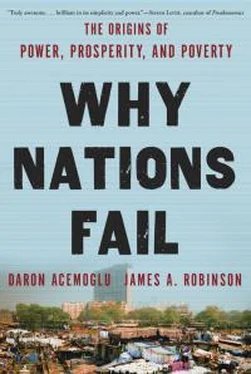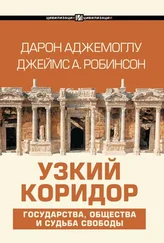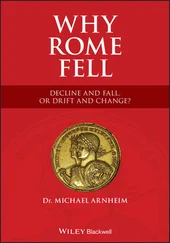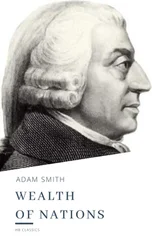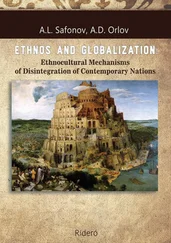SMALL DIFFERENCES THAT MATTER
World inequality dramatically increased with the British, or English, Industrial Revolution because only some parts of the world adopted the innovations and new technologies that men such as Arkwright and Watt, and the many who followed, developed. The response of different nations to this wave of technologies, which determined whether they would languish in poverty or achieve sustained economic growth, was largely shaped by the different historical paths of their institutions. By the middle of the eighteenth century, there were already notable differences in political and economic institutions around the world. But where did these differences come from?
English political institutions were on their way to much greater pluralism by 1688, compared with those in France and Spain, but if we go back in time one hundred years, to 1588, the differences shrink to almost nothing. All three countries were ruled by relatively absolutist monarchs: Elizabeth I in England, Philip II in Spain, and Henry II in France. All were battling with assemblies of citizens—such as the Parliament in England, the Cortes in Spain, and the Estates-General in France—that were demanding more rights and control over the monarchy. These assemblies all had somewhat different powers and scopes. For instance, the English Parliament and the Spanish Cortes had power over taxation, while the Estates-General did not. In Spain this mattered little, because after 1492 the Spanish Crown had a vast American empire and benefited massively from the gold and silver found there. In England the situation was different. Elizabeth I was far less financially independent, so she had to beg Parliament for more taxes. In exchange, Parliament demanded concessions, in particular restrictions on the right of Elizabeth to create monopolies. It was a conflict Parliament gradually won. In Spain the Cortes lost a similar conflict. Trade wasn’t just monopolized; it was monopolized by the Spanish monarchy.
These distinctions, which initially appeared small, started to matter a great deal in the seventeenth century. Though the Americas had been discovered by 1492 and Vasco da Gama had reached India by rounding the Cape of Good Hope, at the southern tip of Africa, in 1498, it was only after 1600 that a huge expansion of world trade, particularly in the Atlantic, started to take place. In 1585 the first English colonization of North America began at Roanoke, in what is now North Carolina. In 1600 the English East India Company was formed. In 1602 it was followed by the Dutch equivalent. In 1607 the colony of Jamestown was founded by the Virginia Company. By the 1620s the Caribbean was being colonized, with Barbados occupied in 1627. France was also expanding in the Atlantic, founding Quebec City in 1608 as the capital of New France in what is now Canada. The consequences of this economic expansion for institutions were very different for England than for Spain and France because of small initial differences.
Elizabeth I and her successors could not monopolize the trade with the Americas. Other European monarchs could. So while in England, Atlantic trade and colonization started creating a large group of wealthy traders with few links to the Crown, this was not the case in Spain or France. The English traders resented royal control and demanded changes in political institutions and the restriction of royal prerogatives. They played a critical role in the English Civil War and the Glorious Revolution. Similar conflicts took place everywhere. French kings, for example, faced the Fronde Rebellion between 1648 and 1652. The difference was that in England it was far more likely that the opponents to absolutism would prevail because they were relatively wealthy and more numerous than the opponents to absolutism in Spain and France.
The divergent paths of English, French, and Spanish societies in the seventeenth century illustrate the importance of the interplay of small institutional differences with critical junctures. During critical junctures, a major event or confluence of factors disrupts the existing balance of political or economic power in a nation. These can affect only a single country, such as the death of Chairman Mao Zedong in 1976, which at first created a critical juncture only for Communist China. Often, however, critical junctures affect a whole set of societies, in the way that, for example, colonization and then decolonization affected most of the globe.
Such critical junctures are important because there are formidable barriers against gradual improvements, resulting from the synergy between extractive political and economic institutions and the support they give each other. The persistence of this feedback loop creates a vicious circle. Those who benefit from the status quo are wealthy and well organized, and can effectively fight major changes that will take away their economic privileges and political power.
Once a critical juncture happens, the small differences that matter are the initial institutional differences that put in motion very different responses. This is the reason why the relatively small institutional differences in England, France, and Spain led to fundamentally different development paths. The paths resulted from the critical juncture created by the economic opportunities presented to Europeans by Atlantic trade.
Even if small institutional differences matter greatly during critical junctures, not all institutional differences are small, and naturally, larger institutional differences lead to even more divergent patterns during such junctures. While the institutional differences between England and France were small in 1588, the differences between Western and Eastern Europe were much greater. In the West, strong centralized states such as England, France, and Spain had latent constitutional institutions (Parliament, the Estates-General, and the Cortes). There were also underlying similarities in economic institutions, such as the lack of serfdom.
Eastern Europe was a different matter. The kingdom of Poland-Lithuania, for example, was ruled by an elite class called the Szlachta, who were so powerful they had even introduced elections for kings. This was not absolute rule as in France under Louis XIV, the Sun King, but absolutism of an elite, extractive political institutions all the same. The Szlachta ruled over a mostly rural society dominated by serfs, who had no freedom of movement or economic opportunities. Farther east, the Russian emperor Peter the Great was also consolidating an absolutism far more intense and extractive than even Louis XIV could manage. Map 8 provides one simple way of seeing the extent of the divergence between Western and Eastern Europe at the beginning of the nineteenth century. It plots whether or not a country still had serfdom in 1800. Countries that appear dark did; those that are light did not. Eastern Europe is dark; Western Europe is light.
Yet the institutions of Western Europe had not always been so different from those in the East. They began, as we saw earlier, to diverge in the fourteenth century when the Black Death hit in 1346. There were small differences between political and economic institutions in Western and Eastern Europe. England and Hungary were even ruled by members of the same family, the Angevins. The more important institutional differences that emerged after the Black Death then created the background upon which the more significant divergence between the East and the West would play out during the seventeenth, eighteenth, and nineteenth centuries.
But where do the small institutional differences that start this process of divergence arise in the first place? Why did Eastern Europe have different political and economic institutions than the West in the fourteenth century? Why was the balance of power between Crown and Parliament different in England than in France and Spain? As we will see in the next chapter, even societies that are far less complex than our modern society create political and economic institutions that have powerful effects on the lives of their members. This is true even for hunter-gatherers, as we know from surviving societies such as the San people of modern Botswana, who do not farm or even live in permanent settlements.
Читать дальше
